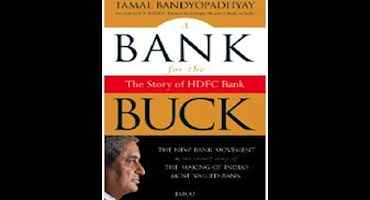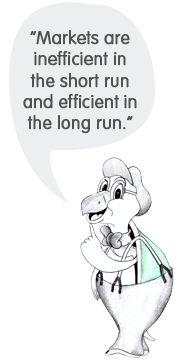Turtle Talk - 17th December 2012
|
|
What's in the frame? |
|
Jayant Pai | [email protected]
|
A Bank for the Buck- A book worth every buck: From the WMG Desk |
|
Ankur Mahajan | [email protected]  "If you like the book; my dear reader, it's because the story of the bank is compelling. If you find it boring, blame the storyteller", writes Tamal Bandopadhayay in the beginning. "A Bank for the Buck" written by Tamal is a classic example of how a book on banking and finance can be so gripping, even for the readers who are not from this background. The book is a story of HDFC Bank, its people who gave birth to it and lead to its current status of India's most valuable bank. Normally books on such subjects can often be monotonous. But Tamal, one of the most respected financial journalist makes the book quite engaging and narrates a non-fiction book like an interesting story, never allowing the readers to get bored.
"If you like the book; my dear reader, it's because the story of the bank is compelling. If you find it boring, blame the storyteller", writes Tamal Bandopadhayay in the beginning. "A Bank for the Buck" written by Tamal is a classic example of how a book on banking and finance can be so gripping, even for the readers who are not from this background. The book is a story of HDFC Bank, its people who gave birth to it and lead to its current status of India's most valuable bank. Normally books on such subjects can often be monotonous. But Tamal, one of the most respected financial journalist makes the book quite engaging and narrates a non-fiction book like an interesting story, never allowing the readers to get bored. The book is based on hundreds of hours of interviews with central bankers, corporate executives, bankers, consumers and investors in different parts of India and overseas. Divided into thirteen chapters, the book begins where Deepak Parekh makes a call to Aditya Puri (who was Chief Executive Officer of Malaysias operation of Citibank N.A) to quit his cushy job and set up a bank in India. Deepak, the Chairman of HDFC had applied for a banking license against the backdrop of the new bank movement in India that started in 1994. The Reserve Bank of India opened up the sector to introduce competition and to forced banks to be efficient and more productive. Deepak could not match the salary Aditya was paid at Citi. But he promised stock options with a simple logic: if the bank is successful he will make good the losses he would suffer by quitting Citi. Aditya took this opportunity of building a bank with the assurance of complete freedom to run. The idea was to bring the best talents from the best banks around the world and build a bank with a world class reputation. The opportunity with HDFC Bank was to give a banking experience better than PSU banks and opening many branches, which the MNC Banks were restricted to. Then began a series of search and appointments for the top management. Some of the key members to join the board were S.S. Thakur (former controller of foreign exchange in India) who eventually became the founder-chairman at HDFC Bank. Next to join was Vinod Yennemadi (former finance director of Kalyani Steels) becoming the CFO and the first employee on the bank's payroll and then many others followed. The commonality in all these people was the fact they took a pay cut, compromised their luxuries from their previous jobs. All they got was a moderate salary and good stock options. In one of the funny instance, the wife of Harish Engineer (who was quitting his well paying job at Bank of America to Join HDFC Bank) started asking silly questions like "Who will pack our furniture? Where will we stay?". Nobody had any idea about how the stock will perform in the future. The book is packed with some warm stories of the initial days; like the training sessions under a tree when there were no meeting rooms at Kamala mills, the ATM swallowing Satwalekar’s (then MD of HDFC) ATM card, employees asked to bring their own coffee mugs to save cost,etc. The book covers the Banks changing focus from institutional to retail and its large focus on advanced technology. It narrates the business philosophy of the bank and how it's different from that of others; particularly ICICI Bank. HDFC bank also couldn't escape the wrath of the regulator when it was penalised twice by the RBI. One chapter focuses on the management style of Aditya Puri and what makes him one of the best bankers in the country. Some of his other characteristics are highlighted; like his priority for work life balance and his frugal nature. Once he promised all his employees to take them to a place where the food would be something they would not have eaten before. He parked the car near a small dhaba and said "lets eat here". He has no computer on his desk, wades through printouts of mails and still manages to leave office at half past five in the evening. This book narrates the trials and tribulations Puri and his hand-picked team went through to create the country's most valued bank. The book is recommended to all the readers who are interested in knowing the untold story of India's most successful bank post liberalisation. And thanks to Tamal, it's an easy and an enjoyable read. |


 William Shakespeare had said "A rose by any other name smells just as sweet". However, marketing heads of companies will disagree with Shakespeare's observation. According to them, a juicy twist to a fact helps in communicating the message better than merely conveying the bald truth. In other words, they are always attempting to frame a fact in the most effective manner. A mutual fund advertisement can state a fact in two ways:
William Shakespeare had said "A rose by any other name smells just as sweet". However, marketing heads of companies will disagree with Shakespeare's observation. According to them, a juicy twist to a fact helps in communicating the message better than merely conveying the bald truth. In other words, they are always attempting to frame a fact in the most effective manner. A mutual fund advertisement can state a fact in two ways: